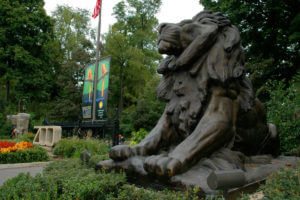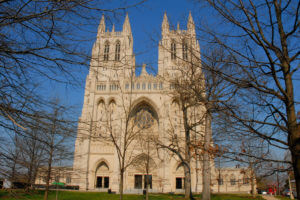Where Does Dc Zoo Get Their Animals
National Zoo

Part of the Smithsonian Establishment, the National Zoo houses more than than 400 species of animals. The zoo'due south founder, naturalist William T. Hornaday, developed the zoo because of his concern over the decline of many native American species. Hornaday envisioned a facility that would brood endangered American animals in captivity and educate the public about wildlife. Although he somewhen left the National Zoo, it continued to grow and today is known around the world for its drove of uncommon animals.
Located in the Woodley Park neighborhood of Northwest Washington D.C., the National Zoological Park is part of the Smithsonian Institution and covers over 160 acres in the picturesque Rock Creek Park. One of the oldest zoos in the U.s., the attraction is home to more than 400 different species of animals. The all-time-known of these residents are the behemothic pandas. The acclaimed zoo collaborates closely with China to breed, study and nurture these dear blackness and white creatures. Approximately 25 percent of the animals that inhabit the park are rare or endangered. Attracting over 2 million visitors annually, this is a sight to run into for animal lovers and families.
History of the National Zoo
 Boasting two big lion sculptures at its main entrance, the National Zoo was founded in 1889 to care for and safeguard endangered animals indigenous to the United states of america. Information technology evolved from the National Museum's Department of Living Animals that was established three years earlier. Aviation pioneer Samuel Langley was director of the Smithsonian during this era and played an instrumental office in creating the park. William Temple Hornaday, founder of the American conservation motility, was the zoo'southward starting time director. Frederick Law Olmsted and Company, i of the nation's most influential landscape architectural firms, designed the park-like zoo. Created to serve as a reminder of the nation's disappearing western frontier, the spacious landscaped setting was a departure from the traditional 19th-century practice of confining animals to limited areas. During its early years, the National Zoo focused mainly on displaying one or ii examples of various species. When a large number of animal species began to decline in the wild, the zoo was 1 of the offset institutions of its kind to design a scientific enquiry program to report, protect and breed threatened and endangered species. The zoo received its first behemothic pandas in 1972, which would get its authentication.
Boasting two big lion sculptures at its main entrance, the National Zoo was founded in 1889 to care for and safeguard endangered animals indigenous to the United states of america. Information technology evolved from the National Museum's Department of Living Animals that was established three years earlier. Aviation pioneer Samuel Langley was director of the Smithsonian during this era and played an instrumental office in creating the park. William Temple Hornaday, founder of the American conservation motility, was the zoo'southward starting time director. Frederick Law Olmsted and Company, i of the nation's most influential landscape architectural firms, designed the park-like zoo. Created to serve as a reminder of the nation's disappearing western frontier, the spacious landscaped setting was a departure from the traditional 19th-century practice of confining animals to limited areas. During its early years, the National Zoo focused mainly on displaying one or ii examples of various species. When a large number of animal species began to decline in the wild, the zoo was 1 of the offset institutions of its kind to design a scientific enquiry program to report, protect and breed threatened and endangered species. The zoo received its first behemothic pandas in 1972, which would get its authentication.
Must-See Exhibits
David Rubenstein Family Giant Panda Habitat
The David Rubenstein Family Giant Panda Habitat is situated in the Asia Trail exhibit and features outdoor and indoor viewing areas. It is dwelling to the zoo'south two adult and two juvenile pandas. The pandas are typically outside from eight a.m. until 2 p.yard. and the indoor viewing area is open to visitors from 10 a.yard. until 6 p.thou. Lines can be long, so you should go far early. Flash photography and video are authorized so make sure you call up to bring a photographic camera.
Other Animal Viewing Areas
While the giant pandas are the most popular attraction at the National Zoo, there are several other highly regarded fauna viewing areas. Along with lemurs, meerkats and naked mole rats in the Modest Mammal Exhibit, you tin see lions, tigers and giant anteaters in the Big Cat Showroom. Other animals on display include elephants, American bison and primates like gibbons, monkeys and lowland gorillas. Observe tortoises, Gila monsters, pythons and alligators upward close at the Reptile Discovery Eye. While Amazonia features animals from South America like the Andean bear and the crimson-bellied piranha, the American Trail exhibit highlights species from N America. Y'all can view beavers, baldheaded eagles and harbor seals. The Bird House is abode to several very colorful species.
Activates for the Kids
Younger children will savour the petting zoo, which features cows, sheep, chickens and miniature donkeys. The zoo also has a playground and an interactive garden where children can learn how pizza ingredients like tomatoes and herbs are grown as well as fun facts virtually pizza from crust to sauce. The zoo likewise sponsors various special events throughout the twelvemonth similar Boo at the Zoo during Halloween and the holiday season Zoo Lights commemoration that feature live entertainment, keeper talks and animal encounters.
Museum Data & Travel Tips
Hours of Performance & Amenities
The National Zoo is open from 8 a.m. until 7 p.m. during the summertime and closes two hours earlier during the winter. The zoo is open up every day except Christmas. Admission to the zoo is free. Several restaurants, snack bars and food carts are located throughout the zoo offering a variety of bill of fare items, including dishes that accommodate diverse dietary requirements. With the exception of help animals, pets are not immune at the zoo.
Getting to the Zoo
Parking is available for a fee, only be aware that the limited spaces fill up fast during the spring and summer months and off-street parking in Northwest D.C. is difficult to find. Because of this, it's recommended you arrive at the zoo via alternative transportation. The zoo is accessible by public transportation, taxi, or ride sharing services. It'southward equidistant from the Cleveland Park and Woodley Park metro stops.
Nearby Attractions
 National Cathedral
National Cathedral
Serving as the 6th largest cathedral in the earth, the National Cathedral is a Neo-Gothic edifice that was completed in 1990. Known officially as the Cathedral Church building of Saint Peter and Saint Paul, the edifice features intricate architectural details and ornate stained glass windows equally well every bit gardens designed past Frederick Law Olmsted, Jr.
Hillwood Estate Museum and Gardens
A decorative arts museum, Hillwood Estate Museum and Gardens is the old residence of philanthropist Marjorie Merriweather Mail service. It features a collection of Faberge eggs, 18th- and 19th-century French artwork and i of the finest orchid collections in the land.
Embassy Row
Diplomatic mission Row is the informal proper name for a stretch of Massachusetts Artery, N.West. running from the The states Naval Observatory to Scott Circumvolve. The roadway is lined with the embassies and diplomatic missions of various countries oftentimes housed in spectacular celebrated buildings. There are also numerous sculptures and other pieces of public art.
 Adams Morgan Neighborhood
Adams Morgan Neighborhood
The nearby Adams Morgan neighborhood is a popular dining and entertainment destination in the city. A hub for nightlife, information technology also hosts a variety of street fairs and other cultural events throughout the year.
Source: https://www.trolleytours.com/washington-dc/national-zoo
Posted by: millerwiffand2002.blogspot.com

0 Response to "Where Does Dc Zoo Get Their Animals"
Post a Comment